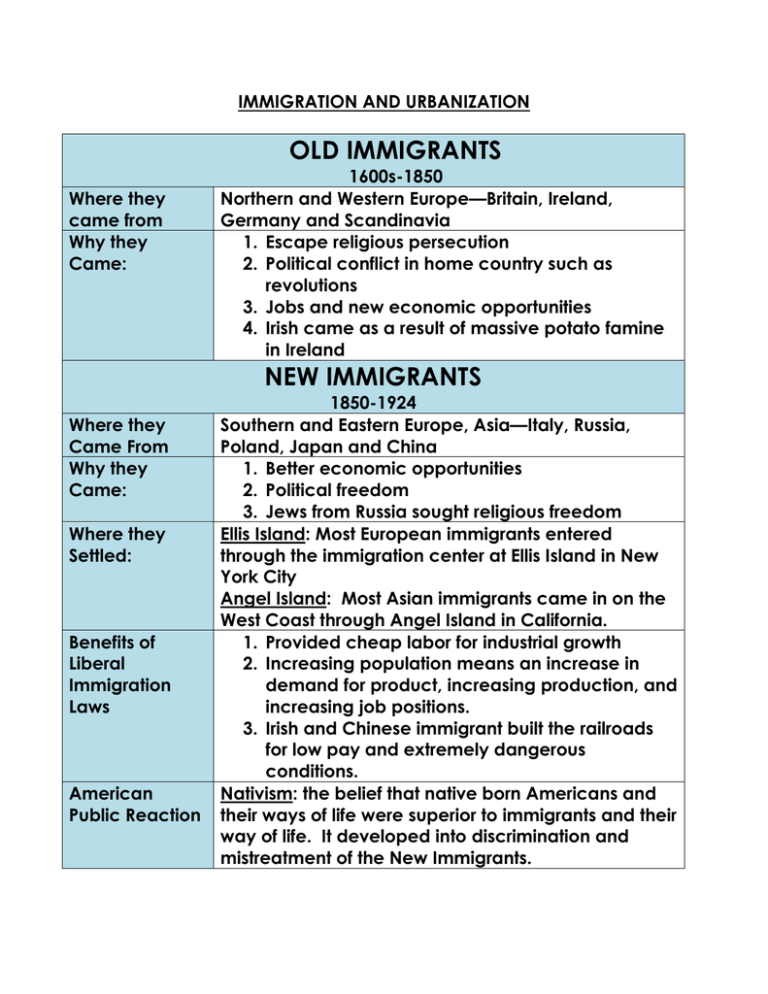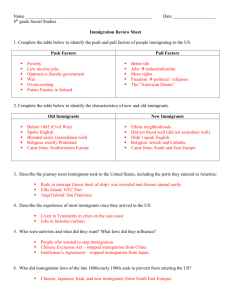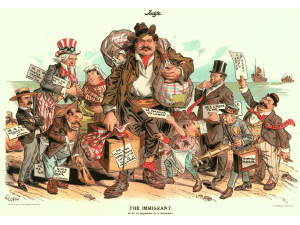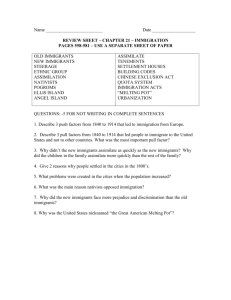
IMMIGRATION AND URBANIZATION
OLD IMMIGRANTS
Where they
came from
Why they
Came:
1600s-1850
Northern and Western Europe—Britain, Ireland,
Germany and Scandinavia
1. Escape religious persecution
2. Political conflict in home country such as
revolutions
3. Jobs and new economic opportunities
4. Irish came as a result of massive potato famine
in Ireland
NEW IMMIGRANTS
Where they
Came From
Why they
Came:
Where they
Settled:
Benefits of
Liberal
Immigration
Laws
American
Public Reaction
1850-1924
Southern and Eastern Europe, Asia—Italy, Russia,
Poland, Japan and China
1. Better economic opportunities
2. Political freedom
3. Jews from Russia sought religious freedom
Ellis Island: Most European immigrants entered
through the immigration center at Ellis Island in New
York City
Angel Island: Most Asian immigrants came in on the
West Coast through Angel Island in California.
1. Provided cheap labor for industrial growth
2. Increasing population means an increase in
demand for product, increasing production, and
increasing job positions.
3. Irish and Chinese immigrant built the railroads
for low pay and extremely dangerous
conditions.
Nativism: the belief that native born Americans and
their ways of life were superior to immigrants and their
way of life. It developed into discrimination and
mistreatment of the New Immigrants.
AMERICAN REACTION AGAINST IMMIGRATION
Know-Nothing Party: the party’s members worked during the 1850s to limit
voting strength of immigrants, keep Catholics from public office, and require a
lengthy residence before citizenship. Also known as the American Party
Chinese Exclusion Act of 1882: Some native-born Americans labeled
immigration from Asia a “yellow peril.” Under pressure from California, Congress
passed this act sharply limiting Chinese immigration.
“Gentlemen’s Agreement”: In 1907 President Roosevelt reached an
informal agreement with Japan under which that nation nearly halted the
emigration of its people to the US. The Japanese who were allowed to emigrate
had to meet very specific standards.
Literacy Tests: 1917 Congress enacted a law barring any immigrant who
could not read or write.
Emergency Quota Act of 1921: This law sharply limited the number of
immigrants to the US each year to 350,000.
National Origins Act of 1924: This law further reduced immigration from
the countries of the “New Immigrants” and in favor of those from northern and
western Europe.
Copied from Regents review book: Briggs,Bonnie-Anne. United States History and Government. 2008 ed. Catherine Fish
Peterson. Boston: Pearson Prentice Hall, 2008.
Introduction
Sociologists have identified a few major
theories on how newly arrived immigrants
integrate themselves into American society.
Over time all new immigrants adopt some
aspects of American culture and add something
new.
"Melting Pot" Theory
According to the Melting Pot Theory peoples
from various cultures come to America and
contribute aspects of their culture to create a
new, unique American culture. The result is
that contributions from many cultures are
indistinguishable from one another and are
effectively "melted" together.
Salad Bowl Theory
According to the Salad Bowl Theory there are
times when newly arrived immigrants do not
lose the unique aspects of their cultures like in
the melting pot model, instead they retain them.
The unique characteristics of each culture are
still identifiable within the larger American
society, much like the ingredients in a salad are
still identifiable, yet contribute to the overall
make up of the salad bowl. It is this theory that
also accounts for the retention of the
"something-American" hyphenation when
identifying cultural identity. This theory is also
referred to as pluralism.
Assimilation
Assimilation is the concept that eventually immigrants or their decedents adopt enough of the
American culture that while they may retain aspects or traditions of their cultural heritage, they
are identifiable as uniquely "American". Most if all of these cultural traditions (language,
foods, etc..) have been replaced with "Americanized" traditions.
Assimilation has proven difficult, even over multiple generations for African-Americans and
other physically unique cultural groups.
(Taken from:
http://www.regentsprep.org/regents/ushisgov/themes/immigration/theories.htm)
2. UNSANITARYAND DANGEROUS CITIES
As industry expanded and millions of immigrants poured into the US, cities
grew rapidly.
Excerpt from How the Other Half Lives,
by Jacob Riis
Be a little careful, please! The hall is dark and
you might stumble over the children pitching
pennies back there. Not that it would hurt
them; kicks and cuffs are their daily diet. They
have little else. Here where the hall turns and
dives into utter darkness is a step, and another,
another. A flight of stairs. You can feel your
way, if you cannot see it. Close? Yes! What
would you have? All the fresh air that ever
enters these stairs comes from the hall-door
that is forever slamming, and from the
windows of dark bedrooms that in turn receive
from the stairs their sole supply of the
elements God meant to be free, but man deals
out with such niggardly hand. That was a
woman filling her pail by the hydrant you just
bumped against. The sinks are in the hallway,
that all the tenants may have access--and all
be poisoned alike by their summer stenches.
Hear the pump squeak! It is the lullaby of
tenement-house babes. In summer, when a
thousand thirsty throats pant for a cooling
drink in this block, it is worked in vain. But
the saloon, whose open door you passed in the
hall, is always there. The smell of it has
followed you up. Here is a door. Listen! That
short hacking cough, that tiny, helpless wail-what do they mean? They mean that the soiled
bow of white you saw on the door downstairs
will have another story to tell--Oh! a sadly
familiar story--before the day is at an end. The
child is dying with measles. With half a
chance it might have lived; but it had none.
That dark bedroom killed it.
This rapid growth led to poorly built housing,
overcrowded cities, and deplorable
conditions.
Tenements: multi-family apartments, poorly
maintained, overcrowded, lack of running
water and sanitation.
Health: Disease spread through cities as a
result of overcrowding, inadequate water
supply, no sanitation or garbage removal.







